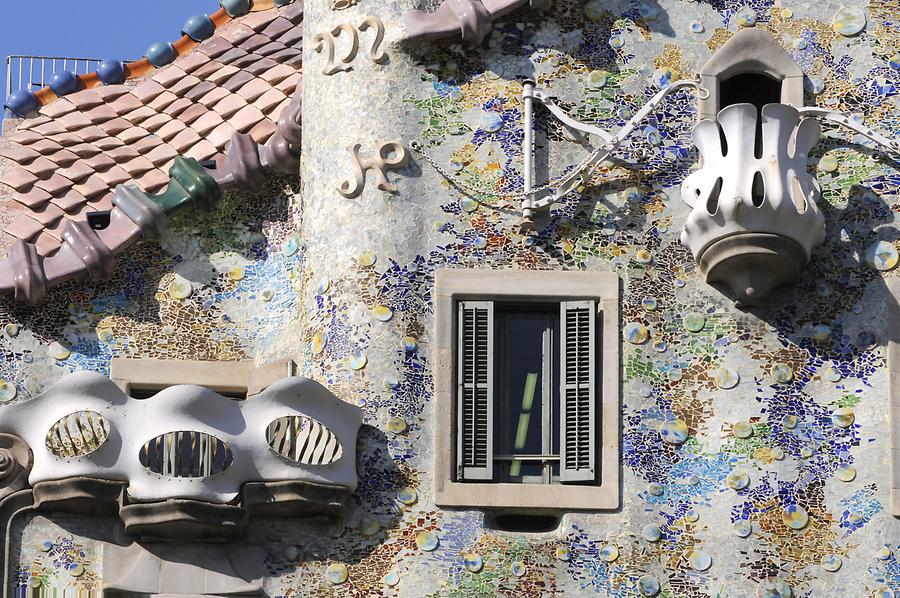Casa Batlló#

Casa Batlló, April 2010, © Gerhard Huber, under CC BY-NC 4.0 +Edu
Here, the Art Nouveau architects could erect memorials in their own honour. In the late 19th century, this art movement arose as a counter-movement to the neo-Gothic and neo-Romanesque aesthetics. It reached its glamorous climax with the Modernisme in Catalonia. In rejection of the unattractive industrial architecture, new concepts were developed on the basis of 'naturalness' and 'movement'. When trying to combine modern iron and concrete structures with elements of Gothic style, nature and materials such as ceramic, glass and wood, bizarre buildings were created that sought after the synthesis of technically feasibility and optimal living quality. An inventive show piece of modernism is the ensemble 'Mancana de la Discordia'. The architects let their imagination run free, but no master builder ventured as much as Antonio Gaudí. He was born in 1852 as the son of a blacksmith and went through a solid training in metalworking before passing his architectural exam in Barcelona. His trademark are irregular floor plans, flowing lines and near-natural soft forms with motifs of flora and fauna. Gaudí developed his buildings during the construction on the basis of sketches and models and it happened again and again that the blueprints had to be changed due to a spontaneous inspiration of Gaudí. Because Gaudí perceived a building as a 'Gesamtkunstwerk', he designed everything himself down to the smallest details of the inside of the building, where he liked to use quarry stones and colourful ceramic tiles. With this he also significantly influenced the style of the Austrian artist Friedensreich Hundertwasser.
Hier konnten sich die Architekten des Jugendstils zahlreiche Denkmäler setzen. Die Kunstrichtung entsprang Ende des 19. Jahrhunderts als Gegenbewegung zur neugotischen und neuromanischen Ästhetik. Sie erreichte mit der Modernisme in Katalanien einen glanzvollen Höhepunkt. In Ablehnung der unattraktiven Industriearchitektur entwickelte man damals neue Konzepte auf Basis von 'Natürlichkeit' und 'Bewegung'. Beim Versuch, moderne Eisen- und Betonkonstruktionen mit Elementen der Gotik, der Natur und Werkstoffen wie Keramik, Glas und Holz zu verbinden, entstanden bizarre Bauten, die nach der Synthese von technisch Machbarem und optimaler Wohnqualität strebten. Ein originelles Schaustück der Modernisme bildet das Häuserensemble Mancana de la Discordia. Die Architekten ließen ihrer Fantasie freien Lauf, doch kein Baumeister wagte sich so weit nach vorne wie Antonio Gaudí. Er wurde 1852 als Sohn eines Kesselschmieds geboren und durchlief eine solide Ausbildung in Metallbearbeitung, bevor er sein Architektenexamen in Barcelona ablegte. Sein Markenzeichen sind unregelmäßige Grundrisse, fließende Linien und naturnahe weiche Formen mit Motiven der Flora und Fauna. Gaudí entwickelte seine Gebäude während des Baus anhand von Skizzen und Modellen und es kam immer wieder vor, dass die Baupläne aufgrund einer spontanen Inspiration Gaudís geändert werden mussten. Da Gaudí ein Gebäude als Gesamtkunstwerk empfand, entwarf er alles selbst bis zu den kleinsten Details im Gebäudeinneren, wo er gerne Bruchsteine und bunte Keramikfließen verwendete. Damit hat er auch den Stil des österreichischen Künstlers Friedensreich Hundertwasser maßgeblich beeinflusst.